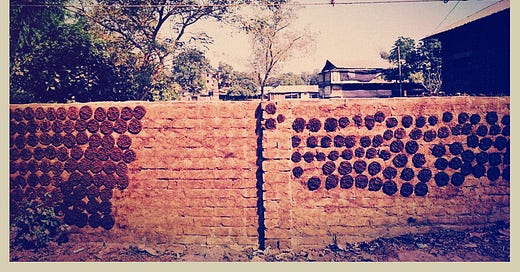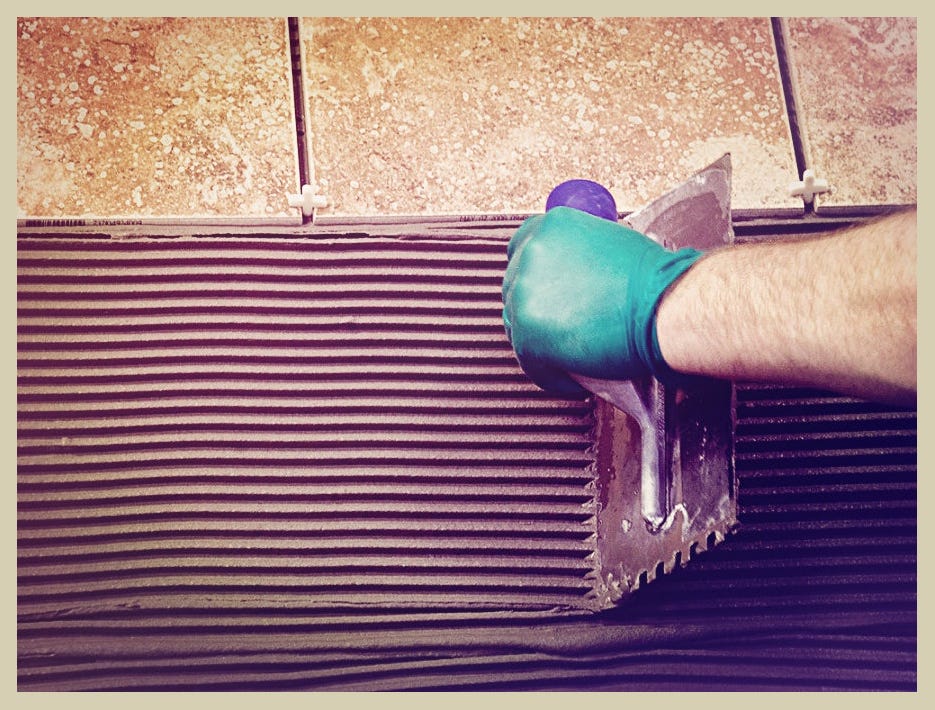I hope everyone is having a wonderful January and thanks for reading. If you have a moment, please let me know what you think in the comments below.
A few years back, as I was in the basement, I heard multiple sharp, thudding noises coming from the center of the floor. As I walked toward the sound, I was startled to see that the bathroom tile had come detached from the wall. With the exception of many mortar daubs, the wall was now clean.
When I was younger, I had some experience installing tile. It was explained to me that the mortar needed to cover the entire tile. However, I'm not an expert, so I wasn't sure if this installation was a different technique. The ceramic tiles were 1/4" thick and measured 2 feet by 2 feet. They were fairly heavy, dense, and firm. If someone had been near them when they fell they would have gotten hurt, possibly badly.
I called my contractor to let him know that the tile had fallen. I said it looked a little off and that I was afraid it would fall again if he put it back the same way. He was exasperated and said “Of course it’s not going to fall again” as if I was a dummy. Whenever I shared a concern, his reaction was to make me feel like I was being difficult. After a while I started to feel like I was a pain in the ass for saying something perfectly normal.
Although it costs money and effort to redo work, contractors seldom seem to realize that it causes bigger problems for the homeowner.
1. I had to pay more for new tile and order it. The contractor refused to take responsibility for his error and I didn’t know that the installation was defective.
2. The tile came from Italy and wasn’t in stock at the local retailer so I had to wait months.
3. The final and worst part was that the new tile might not match in terms of thickness, color, pattern, or size. This can be true even for shades of white. Many people believe that everything contemporary is produced in factories to guarantee uniformity, but that is only partially true.
What causes the variations in tile batches?
Natural raw materials are used to make ceramic tiles. The color, size, and surface quality of each batch of tiles will differ from the last one produced. Numerous factors can influence the ultimate size and look, including the composition of the clay, the final kiln temperature, small adjustments to the glaze, and more.
What went wrong with the tiles?
A subsequent contractor told me that the technique is called spot bonding. The method involves placing several mortar daubs on the back of the tile usually near the corners and sometimes in the center and pushing the tile in place. The Tile Council of North America does not recognize spot bonding as an acceptable method for installing residential tile (See Repository). The method causes an installation to eventually fail, exactly like mine did. The main cause of failure is poor adhesion between the tile and the surface (wall or floor).
A good analogy is gluing a sticky to a larger piece of paper. If you dabbed little spots of glue on the sticky before you stick it on, it will bubble up or curl up at the corners because the entire surface was not completely covered with adhesive.
This method also goes against the ANSI Standards. The American National Standards Institute, or ANSI, is in charge of creating technology standards in the country. Regarding tile installation, the ANSI Specifications' Section A108.5-2.2.2 says:
“Cover surface uniformly with no bare spots and with sufficient mortar to insure a minimum mortar thickness of 3/32” (2 mm) between tile and backing after the tile has been beaten into place.“
Why would anyone spot bond tile?
A level wall or floor is the proper foundation for tile installation. A contractor may use spot-bonding, which eliminates the need for leveling, if they want to save costs. The mortar is simply daubed to the back of the tile and then the tile is squished against the wall until it is level with the tile next to it.
Is the method ever OK to use?
Spot bonding is only appropriate in dry areas utilizing epoxy mortar. Bathrooms and kitchens are considered wet areas. Additionally ceramic and porcelain tiles use thin set and not epoxy.
Contractors may get away with spot bonding if the tile is small. In most other cases, it can come away from the wall. In addition, you may also run into the following issues:
If there is no mortar supporting and pressure is applied to hollow places, the tile may crack.
Grout is permeable and can become worn out. This means that water may seep between, accumulate underneath, and result in mold. Furthermore, some tile and grout types may become discolored by the water.
Last but not least
Remember the fallen tile that was replaced? In 2021, it fell off the wall again. After I fired the contractor. I discovered that it had been installed in the exact same way.
If you enjoyed this post, please like or share. Thank you.
Queen’s Repository
Tile Council of North America (TCNA)
The Tile Council is a trade association representing manufacturers of ceramic tile, tile installation materials, tile equipment, raw materials, and other tile-related products. TCNA regularly conducts independent research and product testing, works with regulatory, trade, and other government agencies, offers professional training, and publishes industry-consensus guidelines and standards, economic reports, and promotional literature.









Nooooo!!! Second time, same way??? Fuck!! I'm not a tile installer but hell, ESPECIALLY with large tile spot bonding seems absolutely ridiculous. Wow.
The tile falling would have been scary and annoying the first time. But when the tiles fell off again, because the contractor had done the same thing — I would have been so angry!
It’s unfortunate that so many of your articles are informed by renovating disasters you experienced, but it does make your articles much more engaging than if they were just some tile installation piece.